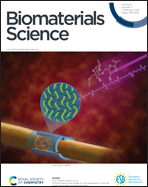An osteoconductive PLGA scaffold with bioactive β-TCP and anti-inflammatory Mg(OH)2 to improve in vivo bone regeneration†
Abstract
Poly(lactic-co-glycolic acid) (PLGA) has been widely used as a biomaterial for pharmaceutical and medical applications. However, the decomposition products of PLGA are known to acidify the surrounding tissue of the implanted site, causing an inflammatory response. Previously, we developed PLGA/inorganic nanocomposites and optimized the amounts of inorganic compounds, β-tricalcium phosphate (β-TCP) and magnesium hydroxide [Mg(OH)2], in terms of osteogenesis of normal human osteoblasts and anti-inflammatory responses of preosteoclastic cells in vitro. In this study, the potential of the optimized PLGA/β-TCP/Mg(OH)2 nanocomposite (TCP/MH) to promote bone repair through osteoinductive, osteoconductive, and anti-inflammatory abilities was assessed using a bone defect in a rat humeral defect model. PLGA nanocomposites with or without inorganic compounds, PLGA, β-TCP, MH, and TCP/MH were prepared through one-step bulk modification using a twin-screw extruder. The resulting TCP/MH nanocomposite successfully enhanced the bone regeneration rate for allowing complete bone defect healing with significantly suppressed inflammatory responses. Taken together, the organic and inorganic bioactive nanocomposite developed in this study, TCP/MH, is a promising material in orthopedic implantation.



 Please wait while we load your content...
Please wait while we load your content...